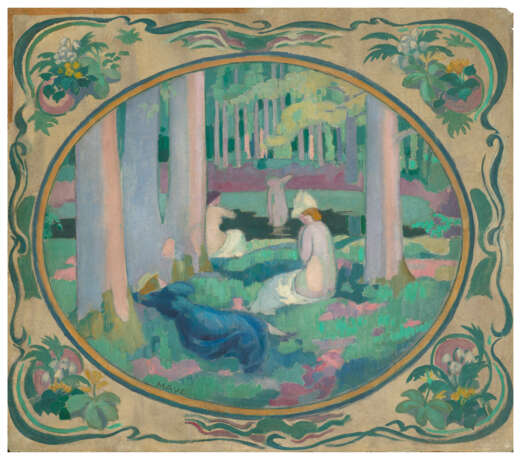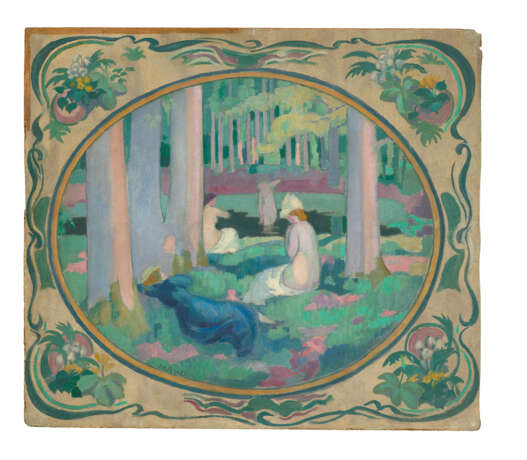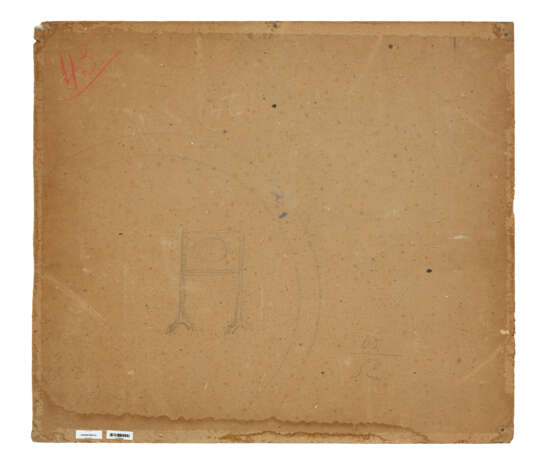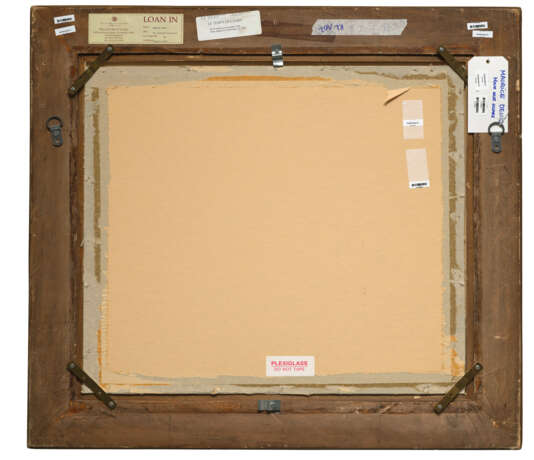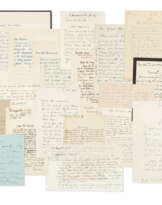ID 1051740
Lot 452 | Maurice Denis (1870-1943)
Estimate value
€ 70 000 – 100 000
Dans la forêt (carton de tapisserie)
signé des initiales ‘MAV.D’ (en bas à gauche)
huile sur carton
51.5 x 59 cm.
Peint vers 1899
signed with the initials 'MAV.D' (lower left)
oil on board
20 ½ x 23 1⁄8 in.
Painted circa 1899
Provenance
Atelier de l'artiste.
Pauline Déjan, France (par descendance).
Sam Josefowitz, Pully (acquis auprès de celui-ci le 8 avril 1989).
Puis par descendance aux propriétaires actuels.
Exhibited
Lyon, Musée des Beaux-Arts; Cologne, Wallraf-Richartz Museum; Liverpool, Walker Art Gallery et Amsterdam, Van Gogh Museum, Maurice Denis, septembre 1994-septembre 1995, p. 162, no. 39 (illustré en couleurs; titré 'The Duckpond Firescreen'; daté ‘vers 1900’).
Florence, Palazzo Corsini et Montréal, Montreal Museum of Fine Arts, The Time of the Nabis, mars-novembre 1998, p. 101, no. 72 (illustré en couleurs, p. 53; titré 'Duck Pond'; daté ‘vers 1900’).
Giverny, Musée des impressionnismes, Maurice Denis, L'Éternel Printemps, avril-juillet 2012, p. 150, no. 45 (illustré en couleurs, p. 107; titré 'Le Bois sacré ou La Mare aux Canes'; daté 'vers 1898').
Further details
Cette célébration arcadienne de la nature a été peinte au tournant du siècle, lorsque Maurice Denis prônait un retour à la simplification traditionnelle et à la pureté des lignes, des couleurs et des formes, telles qu'elles étaient pratiquées par les artistes du Moyen-Âge et du début de la Renaissance, dans sa quête d'une véritable "émotion de la nature". L'harmonie universelle et généralisée est exprimée dans cette œuvre par une composition équilibrée, unifiée par des plans de couleur. Les verticales fortes et profondes des arbres sont soutenues par des bandes horizontales basses de différents tons de vert, sur un fond lumineux de feuillage vert pommelé. La figure féminine en robe bleue allongée au premier plan contraste avec les trois nus pâles à l'arrière-plan, une allusion peut-être au Déjeuner sur l'herbe de Manet, mais sans les connotations érotiques. Les guirlandes qui entourent la composition ovale rappellent au spectateur la fonction décorative du tableau, un principe auquel les Nabis étaient très attachés. Comme le déclarait l'artiste néerlandais Jan Verkade, "le travail du peintre commence là où celui de l'architecte s'achève. C'est pourquoi nous avons des murs, afin de pouvoir les peindre. ...Il n'y a pas de peinture mais seulement de la décoration" (Verkade cité dans Pierre Bonnard, Observing Nature, cat. exp., National Gallery of Australia, Canberra, 2003, p. 83). La présente peinture a été transférée sur de la tapisserie, puis assemblée avec des pieds pour servir de pare-feu.
La forêt est un thème cher à l'artiste qui a grandi en dessinant les bois voisins de Saint-Germain-en-Laye. En 1900, il reprend ce thème à plusieurs reprises, de manière allégorique dans Le Jeu du Volant (Paris, musée d'Orsay) ainsi que dans les Nymphes aux jacinthes, une grande composition d'intérieur pour la salle à manger du comte Kessler à Weimar, aujourd'hui détruite. Dans son journal, il raconte l'émerveillement que lui inspiraient les bois. "J'arrive à un endroit luxuriant de la forêt où il y a des arbres, tordus, crochus, hauts, feuillus... certains sont jaunes, d'autres verts, d'autres gris. Pour l'œil de l'artiste, c'est si beau que c'est vertigineux, mais il faut l'étudier avec le pinceau pour bien saisir les effets du soleil, de la lumière, du grand air, de l'ombre, du crépuscule" (op. cit., p. 37).
This arcadian celebration of nature, was painted at the turn of the century when Maurice Denis advocated a return to a traditional simplification and purity of line, colour and form, as practised by Medieval and early Renaissance artists in his quest for a true “émotion de nature”. Universal and generalized harmony is expressed in the present work through a balanced composition unified by colour planes. The scene is solidly structured by the trees' verticals, which in turn, are grounded by horizontal bands of different tones of greens, set against a luminous background of dappled green foliage. The female figure in a blue dress lying in the foreground contrasts with the three pale nudes in the background, an allusion perhaps to Manet's Déjeuner sur l'herbe, yet omitting any erotic overtone. The swags and garlands framing the oval composition remind the viewer of the decorative function, a closely-held tenet of the Nabis. As the Dutch artist Jan Verkade declared “the work of the painter begins where that of the architect is finished. Hence let us have walls, that we may paint them over. …There are no paintings but only decoration' (Verkade quoted in Pierre Bonnard, Observing Nature, exh. cat, National Gallery of Australia, Canberra, 2003, p. 83). The present painting was transferred to tapestry, and then assembled as a fire-screen to which were added feet.
Growing up sketching the surrounding woods of Saint-Germain-en-Laye, the forest was one of the artist's favorite themes. In 1900, he revisited this theme many times, in an allegorical fashion in Le Jeu du Volant (Paris, Musée d'Orsay) as well as in the now destroyed Nymphes aux jacinthes, a large interior composition realised for the dining room of Count Kessler in Weimar. Denis described the wonder of woods in his Journal : “I reached a luscious spot in the forest where there are trees, twisted, crooked, tall, leafy...some yellow, some green, some grey. For the artist's eye, it is so beautiful that it imakes one dizzy, but it needs to be studied with the brush to fully capture the effects of the sun, the light, the open air, the shade, the twilight” (op. cit., p. 37).
| Artist: | Maurice Denis (1870 - 1943) |
|---|---|
| Applied technique: | Oil, Painted |
| Auction house category: | Paintings |
| Artist: | Maurice Denis (1870 - 1943) |
|---|---|
| Applied technique: | Oil, Painted |
| Auction house category: | Paintings |
| Address of auction |
CHRISTIE'S 9 Avenue Matignon 75008 Paris France | ||||||||||||||
|---|---|---|---|---|---|---|---|---|---|---|---|---|---|---|---|
| Preview |
| ||||||||||||||
| Phone | +33 (0)1 40 76 85 85 | ||||||||||||||
| Fax | +33 (0)1 40 76 85 86 | ||||||||||||||
| Conditions of purchase | Conditions of purchase | ||||||||||||||
| Shipping |
Postal service Courier service pickup by yourself | ||||||||||||||
| Payment methods |
Wire Transfer | ||||||||||||||
| Business hours | Business hours
|
